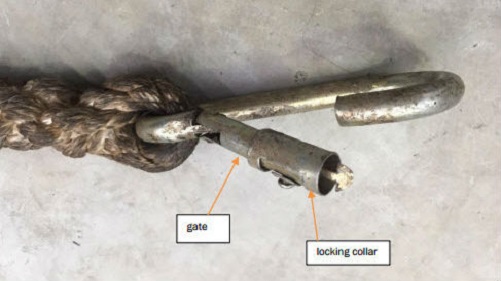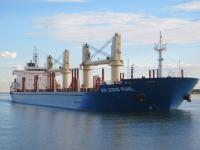The New Zealand Transport Accident Investigation Commission has released its report into the death of man on the bulk carrier, New Legend Pearl in November 2016, citing both equipment and safety practice failings.
The bulk carrier was east of Coromandel Peninsula on passage between the New Zealand ports of Bluff and Marsden Point when the accident occurred. The crew were attempting to change a hoisting wire on one of the vessel's cargo cranes. Part-way through the task the hoisting wire snagged on the crane jib that was resting in its cradle, about eight metres above the hatch cover.
The bosun donned a safety harness and climbed up onto the crane jib, secured the lanyard of his harness around a luffing wire and walked along the jib to unsnag the wire. However, the lanyard prevented him reaching the snag, and he was in the process of transferring the lanyard to a different securing point when he lost his balance or slipped and fell eight metres to the deck below. He died from his injuries.
There were no designated fall-prevention anchor points on the cranes, so the crew regularly secured their lanyards to convenient fixings or wires. The bosun had passed his lanyard around one of the crane’s luffing wires, then hooked it back onto itself. This is not recommended unless the lanyard and hook have been specifically designed for that purpose, and after the accident the gate on the bosun’s safety harness hook was found bent sideways and it no longer married up with the end of the hook.
The Transport Accident Investigation Commission found that it was about as likely as not that the locking mechanism for the safety harness hook was not engaged, which allowed the lanyard to roll or burst out of the hook when the bosun fell, and that the safety harness was not suitable for the intended task. The harness should have had a more robust hook and lanyard arrangement, designed to be tied back on itself and with dual lanyards to enable safe transfers between securing points.
The risk assessment conducted prior to the crew starting the wire replacement on crane number 2 did not fulfil the requirements of the operator’s safety management system, because it did not adequately identify and manage the risks associated with the task. The repeated failures of the crew to comply with safe working practices when working at height and the acceptance of using a substandard wire on a working crane are indications of a poor safety culture on board the New Legend Pearl, says the Commission.
The Commission recommended that the general director of the Panama Maritime Authority seek improvements in the operator’s implementation of its safety management system on board its vessels, including the underlying safety culture.
The report is available here.



Comments
Post a Comment